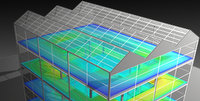Research & Development
We can help you develop your own solutions with our technologies.
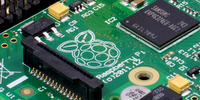
ENSIMS
Raspberry PiTM, the $25 credit card sized computer is taking over the world by storm! This tiny ARM-based Linux box has been found in numerous novel applications. Can it be the next "big thing" in the field of energy simulation? We certainly think so!
The Raspberry Pi draws only 3 watts of power. If it can run simulations, it must be the most energy efficient solution for the energy simulation user. Unfortunately, the ARM-based processor is not strong enough to handle detailed building models such as EnergyPlus. Luckily, you do not have to run simulations on the little box, in order to use simulation results. With other ENSIMS products and our remote simulation solutions, your RPi can send simulation jobs to a X3200 or a K800, and get results back fast. With the remote simulation capability, you can use parametric analysis and optimisation on the little box.
The package
The E+Pi package we offer includes:
- A Raspberry Pi Model B in clear plastic enclosure
- An 8GB Class 10 SDHC card preloaded with Raspbian, Python, jEPlus+EA and JESS Client
- Online documentation and examples on how to use RPi for energy simulation
Development
The E+Pi is offered as a development platform targeting control and monitoring applications. We offer consultancy and development service to help you with your project.

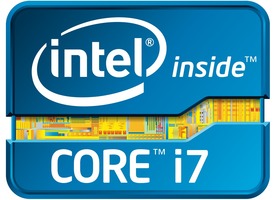 Did you know that modern computer components offer plenty of headroom for performance enhancement than the official specs on the box? Most mainstream manufacturers will not allow you to do that for a very good reason: it is a risky operation and requires knowledge and skills to get it right. The K800 computers have been built from scratch using only the best components for performance tuning. You will get a robust and super fast desktop computer which is also nearly silent in day-to-day use.
Did you know that modern computer components offer plenty of headroom for performance enhancement than the official specs on the box? Most mainstream manufacturers will not allow you to do that for a very good reason: it is a risky operation and requires knowledge and skills to get it right. The K800 computers have been built from scratch using only the best components for performance tuning. You will get a robust and super fast desktop computer which is also nearly silent in day-to-day use.
The Computer
|
Chassis: |
High quality MB and enclosure for near silent operation |
|
|
Processors: |
Intel Core i7 4790K, performance tuned |
|
|
Memory size: |
Upto 32GB of RAM, performance tuned |
|
|
Storage size: |
250/500GB Solid state HD, plus additional high capacity drives upto 8 TB in total. |
|
|
Power supply: |
500W 80Plus Gold power supply unit |
|
|
Other components: |
Other specialized components can be added by order |
|
|
Operating system: |
User's choice of OS can be ordered separately |
|
|
JESS software: |
JESS server or execution node software are available at additional cost |
Included Services and Support
|
All K800 computers include the following services and support as standard:
|
Price
Starting from £999 plus VAT.
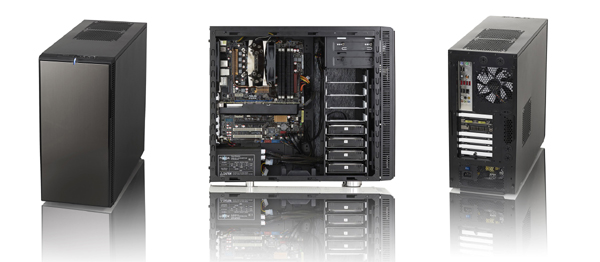
* Images for illustration only. Actual product may vary.
You can download tools, benchmark models, and product documentation here.
Benchmark model sets
E+ benchmark set
DOC benchmark set
The ENSIMS X3200 series offers exceptional computing performance, as well as an optimum balance between the simulation throughput and the energy efficiency.
 The servers are based on the Dell PowerEdge T620 tower server line. It has two Intel Xeon E5-2600v3 processors, with the top of the range E5-2699v3 sporting an incredible 18 cores per processor(!) which means you can run up to 72 simulations in parallel. Both memory and storage systems of X3200 are optimized to achieve best throughput and reliability. Depending on your business needs, the selection of the right configuration becomes very import. More expensive options do not always yield better performance. We will help you choose the right product that fits your demand best.
The servers are based on the Dell PowerEdge T620 tower server line. It has two Intel Xeon E5-2600v3 processors, with the top of the range E5-2699v3 sporting an incredible 18 cores per processor(!) which means you can run up to 72 simulations in parallel. Both memory and storage systems of X3200 are optimized to achieve best throughput and reliability. Depending on your business needs, the selection of the right configuration becomes very import. More expensive options do not always yield better performance. We will help you choose the right product that fits your demand best.
The X3200 series supports both Linux and Windows operating systems. The jEPlus Simulation Server (JESS) software is used to support multiple concurrent simulation users, and execute energy simulations efficiently. The Simulation Server provides a cost effective and energy efficient solution to energy professionals who require frequent access to computing power for energy simulations.
Computer Platform
Hardware
|
Chassis: |
Dell Inc. PowerEdge T620, in tower or rack mounted configuration |
|
|
Processors: |
32 to 72 threads powered by 2 x Intel Xeon E5-2600v3 processors |
|
|
Memory size: |
Upto 128GB of registered ECC memory |
|
|
Storage size: |
Upto 16 TB of hard drives in RAID 0, 1, 10 or 5 configurations |
|
|
Power supply: |
Upto two 750W - 1,100W 80Plus Platinum hot-pluggable redundant power supply units |
|
|
Warranty: |
Dell 3 year next-day onsite warranty and ProSupport (UK only) |
|
|
EnSimS support: |
Upto 3 year EnSimS support on remote simulation and free upgrade to the JESS platform |
Operating System
Ubuntu Linux Server 14.04 LTS or Microsoft Windows 7 Professional by default, installed and configured. Other operating systems are available on request.
Simulation Manager
JESS v1.5 for Local/LAN installed and configured, with multiple EnergyPlus version support, and the support for other simulation engines on request. Other simulation managers or server software may be available on user's request.
Services and Support
|
All X3200 servers include the following services and support as standard:
Additional services may include:
* Installation and on-site configuration are available to UK customers only. Overseas customers may be liable for additional shipping cost and import tax. |
Price
Starting from £7,500 plus VAT.
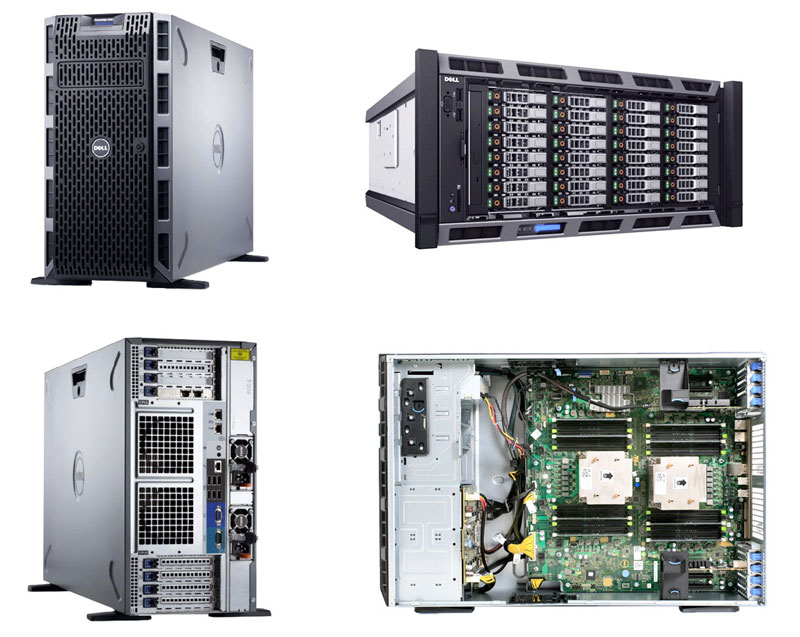
Two benchmark model sets were used for testing the performance of the ENSIMS computers and comparing them to typical desktop and laptop PCs. The first set comprises selected example models shipped with EnergyPlus. More details can be found on the jeplus.org website.
The second benchmark set is based on the type of building models that practitioners create using DesignBuilder software. It aims to represent more realistic use cases, where simulation times and simulation output levels can vary widely. 24 models from the Design Optimisation Competition (DOC2012) were included in this benchmark set. They represent a good range of simulation complexity. PCMs, natural ventilation calculations and daylight-based lighting controls are known time consuming design options in terms of simulation. They are represented in the model set. The models use a number of different construction types, built forms, and glazing arrangements. Unfortunately, detailed HVAC has not been represented in the set. More details on the models included in this benchmark set can be found in Table 1 below.
Table 1 DOC 2012 models
| Model | Form | Glazing ratio | Roof lights | Construction | System | Ventilation | Daylight |
|---|---|---|---|---|---|---|---|
| 018 | L shaped, 6 floors | 50% | No | PCM | LTHW radiator heating | Mixed | Yes |
| 050 | Square, 5 floors | 50% | No | Medium | GSHP | Mixed | Yes |
| 054 | Mainly square, 2 floors | 70% | Yes | Medium | LTHW | Mixed | Yes |
| 060 | Sloping double skin south wall, 6 floors | 20%-50% variable | No | Medium | GSHP | Mixed | No |
| 077 | Square, 2 floors of different sizes | 35% | Yes | Heavy | LTHW | Mixed | Yes |
| 094 | Rectangular with wings, 5 floors | Variable | Yes | Light | VRF | Mechanical | Yes |
| 100 | Circular with a square top, 3 floors | 36% | Yes | Medium | ASHP | Natural | Yes |
| 109 | Rectangular with curved wall, 4 floors | Low % | No | Medium | Fan Coil | Mechanical | No |
| 116 | Square with overhangs, 4 floors | 50% | Yes | Medium | LTHW | Mixed | Yes |
| 128 | Distorted ‘H’ shape, 5 floors | Mostly 35% | No | Medium | LTHW | Natural | No |
| 130 | Rectangular, 6 floors | 0%- 25% variable | No | Light | LTHW & chilled beams | Mechanical | Yes |
| 140 | Rectangular, 5 floors | 30%-46% variable | No | Medium | GSHP | Natural | Yes |
| 158 | Rectangular, 4 floors | 60%-100% variable | Yes | PCM, light | VRF | Mixed | Yes |
| 173 | Irregular rectangle, 5 floors | High% S, Low% E/W/N | No | Medium | ASHP | Natural | Yes |
| 182 | Rectangular “stepped”, 4 floors | 50% S, low % E/W/N | Yes | Medium | VRF | Mechanical | Yes |
| 185 | Irregular rectangular polygon, 4 floors | 90% | No | Medium | GSHP | Mixed | Yes |
| 204 | Circular tower, 5 floors | 50% | No | Medium | VRF | Mechanical | Yes |
| 207 | Irregular U shap, 4 floors | 50% | No | Light | LTHW | Natural | Yes |
| 209 | Wide rectangular, 6 floors | 40% | No | Medium | VRF | Mechanical | Yes |
| 210 | H shaped, 4 floors | 85% S/N, 0% E/W | No | Medium | VRF | Mechanical | Yes |
| 213 | L shaped, 4 floors | 70% | No | Medium | VRF | Mixed | Yes |
| 214 | L shaped, 4 floors | 37% | No | Medium | LTHW | Natural | Yes |
| 216 | H shaped, 4 floors | 50% | No | Medium | Fan Coil | Mechanical |
No |
| 222 | Rectangular with courtyard, 4 floors | 40% | No | Light | LTHW | Natural | Yes |
The EnergyPlus models were exported from DesignBuilder, and then converted to E+ version 8. Orientation was added as an additional parameter, to create more simulation cases. A UK (London) weather file was used in all tests. The chart below shows the distribution of the average simulation time of each model, when executed on X3290 using 8 parallel threads. The simulations were done with no output files generated. Further tests also include three different output levels: no output, DesginBuilder's default output setting at hourly level, and DesignBuilder's all output setting at hourly level. These were used to test the impact of disc I/O on simulation performance.
Figure 1 Typical simulation time of the benchmark models
Subcategories
Products
EnSimS products information
Benchmark
Product test results and reports.
Consultancy
Expert consultancy service information.
About
General information about the company.
Support
Support information includes downloads and documentation.
Solutions
Articles about the technical solutions ENSIMS can provide through research and development.
JESS
Articles about the JESS online service
News and Events
Latest news and upcoming events.









